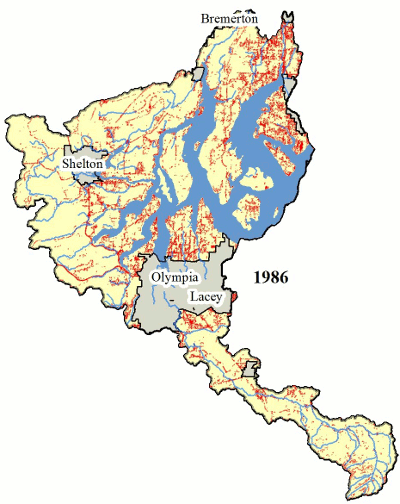State of Our Watersheds: Paving in deep South Sound
In the recent State of Our Watersheds Report, the Squaxin Island Tribe points to a drastic increase in impervious surface, especially outside urban growth boundaries. The animation below illustrates the growth in salmon harming pavement and hard surfaces.
From 1986 to 2006, the Squaxin Island Tribe’s Area of Concern saw a 49% increase in impervious surface (Total Impervious Area, TIA) in the total land area outside of cities and Urban Growth Areas, accounting for an additional 11 square miles. The Chinook Recovery Plan for South Sound identified an objective to promote land-use practices that prevent stormwater flows. This objective calls for the preservation of native land cover and natural drainage systems, while limiting the area and connectivity of impervious surfaces (CRPSS, 2005).
The Squaxin area of concern has several basins that have less than 10% impervious surface and generally more than 65% forest cover. The best conditions are found in the Skookum Creek and Coulter Creek basins. Other basins with relatively low impervious surface and high forest cover include Rocky, Sherwood, Deer, Cambell, Uncle Johns, Cranberry, Malaney, Johns, Goldsborough, Mill, Kennedy, Schneider, Perry, McLand and the upper Deschutes. These basins have the best chance for biological recovery and should be prioritized for Puget Sound restoration. Achieving this protection will be key to the survival of salmon and steelhead in the South Sound.
South Sound is one of the fastest growing areas in the state, exceeding the State’s growth rate consistently since the 1960s. Much of this growth is clustered around Puget Sound’s Inlets, or near and around streams that feed into Puget Sound. Research shows that as development increases beyond 10% impervious cover and less than 65% forest cover, streams and their fisheries are severely degraded, making them expensive or impossible to recover (Booth, Harley & Jackson, 2002).

